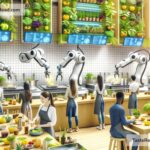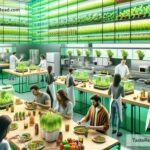The Future of Food and Collaborative Sustainability: A Path to a Healthier Planet
The way we produce, eat, and think about food is changing fast. As our world grows, both in population and technology, we need to find better ways to feed people while taking care of our planet. This journey toward better food systems isn’t just about adopting new technologies—it’s also about coming together to work toward a common goal: sustainability. In this article, we’ll explore how the future of food is tied to collaboration, innovation, and a shared commitment to creating a healthier and greener Earth.
The Challenge We Face
Our current food system faces big challenges. Climate change, soil erosion, water scarcity, and rising greenhouse gas emissions are all putting pressure on how we grow and deliver food. At the same time, the global population is expected to reach nearly 10 billion by 2050. That means we need to produce more food while reducing harm to the environment. But how can we do this?
The answer lies in shifting from old, wasteful methods to sustainable and collaborative ways of operating.
The Future of Food Is Smarter and Greener
Smart technology will play a key role in shaping the future of food. Agricultural innovations such as precision farming, vertical farms, and lab-grown food are helping us grow crops more efficiently. Here are a few examples:
-
Precision Farming: Farmers use sensors, drones, and data analytics to monitor soil, weather, and crop health. This helps them reduce waste by applying water, fertilizer, and pesticides only where they’re needed.
-
Vertical Farming: Instead of growing crops on large fields, vertical farms grow plants inside buildings using stacked layers. These farms use LED lights, save water, and can produce food year-round, even in cities.
-
Lab-Grown Meat: Scientists can now grow real meat in labs using animal cells. Known as cultured or “clean meat,” this could reduce the need for farming animals, cutting down emissions and land use.
These advancements are exciting, but technology alone isn’t enough. We also need collaboration—people working together on shared goals.
Collaborative Sustainability: A Team Effort
Sustainability isn’t just one person’s or one company’s responsibility. It requires teamwork across governments, businesses, communities, and individuals. When we collaborate, we can come up with faster, smarter solutions to improve food systems around the world. Here’s how different groups are playing their part:
Governments and Policymakers
Governments can make it easier for sustainable practices to succeed. They can offer support to farmers who use eco-friendly methods, pass laws to protect biodiversity, or fund research into new farming technologies. By creating policies that prioritize sustainability, they set the stage for a healthier food system.
Businesses and Entrepreneurs
Food companies have started working towards reducing waste, emissions, and energy use. For example, some companies turn leftover food into compost or reusable bio-materials. Others are investing in plant-based food products and eco-friendly packaging. Entrepreneurs are also leading the way by innovating new ideas, like carbon-neutral coffee or protein-rich foods made from insects.
Communities and Local Farmers
Smaller groups, like communities and local farmers, play an important role. Many farmers are adopting regenerative agriculture, which restores soil health and improves crop yields without damaging the environment. Community-supported agriculture (CSA) programs connect local farmers directly with consumers, reducing transportation emissions while giving people access to fresh food.
Individuals
Every person can make a difference, too. By choosing locally grown produce, eating less meat, composting food scraps, or simply wasting less food, we help reduce the strain on the food system. Many people are also joining community gardens or volunteering for food charities—small actions that can add up to big change.
Food Waste: A Problem We Can Solve Together
One major issue that requires collaboration is food waste. Globally, about one-third of all food produced is wasted—either thrown away or left to rot. This is bad for the environment and unfair to the millions of people who go hungry every day.
Solving food waste takes teamwork. Grocery stores can donate unsold food to food banks. Restaurants can offer smaller portion sizes or use apps to sell leftovers at discounted prices. Individuals can plan meals to avoid overbuying or save uneaten food for later. When everyone plays their part, we can waste less and share more.
Looking Ahead: A Unified Vision
The future of food doesn’t have to be a gloomy picture. In fact, it can be bright if we work together. When governments, businesses, farmers, and everyday people join forces to create sustainable practices, we can solve some of the biggest food challenges. By focusing on smarter technologies and mutual collaboration, we can create food systems that are kinder to the planet and more equitable for people everywhere.
What Can You Do?
You don’t have to be a scientist or politician to help build a sustainable future. Every small action counts. Start by buying local, eating seasonal foods, and reducing waste. Share knowledge with friends and family or support eco-conscious brands that care about the environment. The key is to think of food not just as something you consume but as something that connects us to the Earth and to each other.
The future of food is everyone’s responsibility. Together, we can shape a world where food is not just delicious but also sustainable, fair, and accessible to all. Let’s embrace this journey toward collaborative sustainability and make a difference for generations to come.

